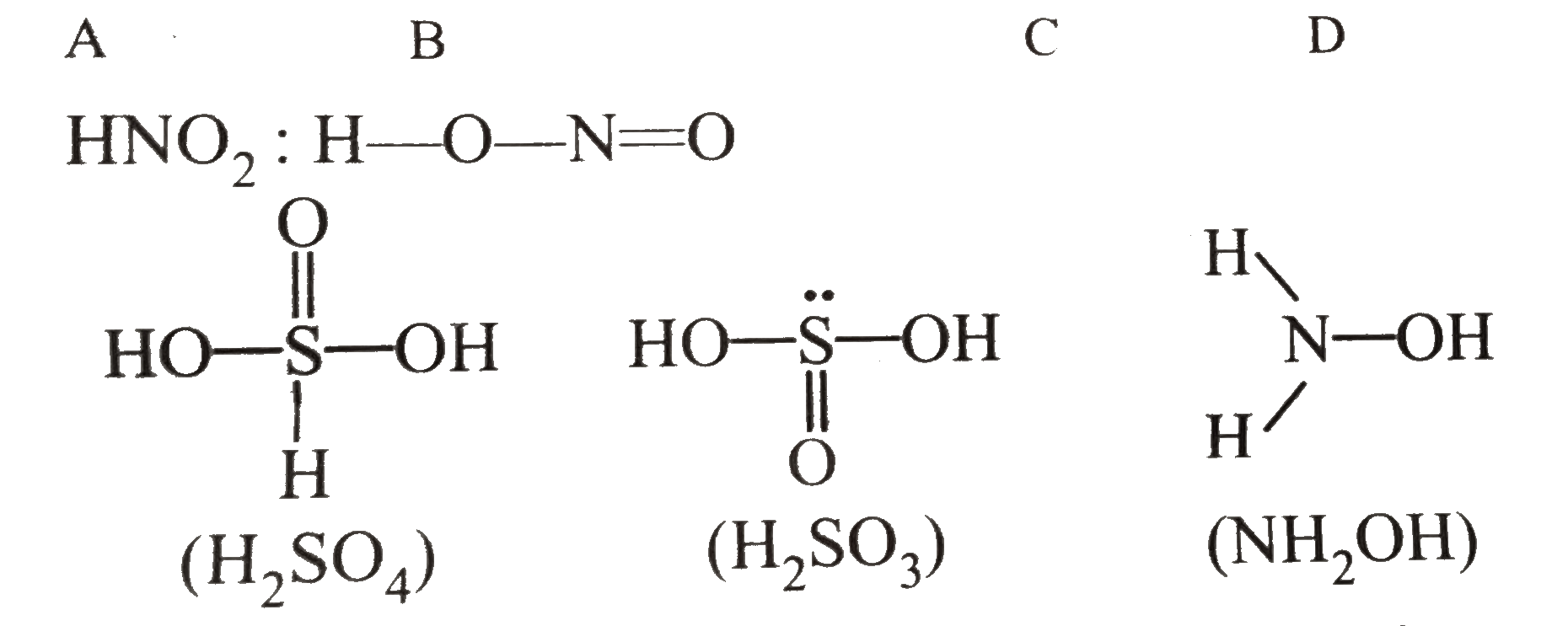In the following equation :
A+2B+H2O→C+2D
A=HNO2,B=H2SO3,C=NH2OH
Identify D. Draw the structure of A,B,C and D.
HNO2A+2H2SO3B+H2O→NH2OHC+2H2SO4D.
 .
.
Topper's Solved these Questions
- BOOK - CENGAGE CHEMISTRYCHAPTER - P-BLOCK GROUP 15 ELEMENTS - THE NITROGEN FAMILYEXERCISE - Exercises Archives (True/False)2videos
P-BLOCK GROUP 15 ELEMENTS - THE NITROGEN FAMILY
- BOOK - CENGAGE CHEMISTRYCHAPTER - ORGANIC COMPOUNDS WITH FUNCTIONAL GROUPEXERCISE - Archives Analytical And Descriptive24videos
ORGANIC COMPOUNDS WITH FUNCTIONAL GROUP
- BOOK - CENGAGE CHEMISTRYCHAPTER - P-BLOCK GROUP 16 ELEMENTS - THE OXYGEN FAMILYEXERCISE - Archives Subjective10videos
P-BLOCK GROUP 16 ELEMENTS - THE OXYGEN FAMILY
Similar Questions
Knowledge Check
- Question 1 - Select One
Consider the following sequence of reactions:
B2O3+CaF2+H2SO4→(A)+(B)+H2O
(A) +LiAlH4→(C)(g)+(D)+LiF
(C) +H2OΔ→(D)+H2↑⏐
(D) +Na2CO3→(E)+NaBO2+CO2↑⏐
(E) +NH4Cl→(F)+B2O2+NaCl+H2O
The emipirical formula mass of compound (F)A25B15C50D117.5 - Question 2 - Select One
[A]+[B]→C2H5NHCONHC2H5
(a)COCl2(b)ALCl3(c)C2H5NH2(d)CH2Br2
here , [A] & [B] areAa,bBb,cCc,dDa,c
Explain whether oxidation, reductio, or neither occurs in the following reactions :
(a) H2C=CH2→H3C−CH3
(b) HC≡CH→H3C−CH=O
( c) CH4→CH3OH
(d) H2CBr2→H2C=O
II. Give the structural formula for the simplest hydrocarbon in which C has a zero O.N.View SolutionComlete the following reactions :
i.C2H5NH2+CHCl3+Alc.KOH→
ii. C6H5N2Cl+H3H3PO2+H2O→
iii. C6H5NH4+H2SO4(Conc.)→
iv. C6H5H2cl+C−H5OH→
v. C6H5NH2Cl+C2H5OH→
vi. C6H5NH2+Br2(Aq.)→.
vii C6H5N2Cl(i)HBF4−−−−−−−−−−−−→(ii)NaNO2/Cu,ΔView Solutiona. (A) (yellow coloured solution ) changes to light green coloured solution (B) on passing H2S gas (A) and (B) both give white ppt. with BaCI2 solution, insoluble in conc. HCI(A) given blue coloured ppt (C ) with K4[F2(CN)6] B does not .What are (A),(B) and (C )?
b. Identify A,B,C and D in the following reactions Bauxite + chemical +CI2Δ−−→A+CO
A+H2O→B+HCI,B+H2SO4→C+H2O
B+NaOH→D+H2OView SolutionIn the following reactions, identify the compounds A,B,C and D.
(i) PCl5+SO2→A+B
(ii) A+MeCOOH→C+SO2+HCl
(iii) 2C+Me2Cd→2D+CdCl2.View SolutionA+NH4+BCGlatamate+H2O+D complete the above conversion with suitable option for A, B C and D.
View SolutionIn an equilateral triangle ABC if AD⊥BC, then AD2 = (a)CD2 (b) 2CD2 (c) 3CD2 (d) 4CD2
View Solution

